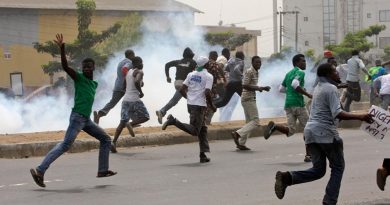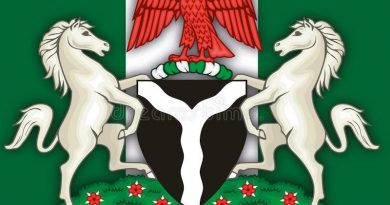Adopting Electronic System of Verifying Military Pensioners in Nigeria, by Saburi Abayomi Lawal — Economic Confidential

Adopting Electronic System of Verifying Military Pensioners in Nigeria, by Saburi Abayomi Lawal
INTRODUCTION
1. The Military Pensions Board (MPB) is statutorily charged with the administration and payment of gratuities and pensions of military retirees as well as payment of death benefits to Next-of-Kins (NOKs) of deceased personnel of the Armed Forces of Nigeria (AFN). To effectively do this, MPB has, over the years, carried out major internal reforms, some of which include the computerization of its operations, installation of the manual and digital archiving systems as well as computerization and re-organization of gratuity and pensions payment system to eliminate unnecessary delays. In consonance with the reforms, the Board has now identified that there is an urgent need to jettison the expensive and archaic manual system of verifying military pensioners which often subjects aged military retirees to untold hardships and replace it with an electronic system which will facilitate remote verification of military pensioners, in line with global best practices. The purpose of this article therefore is to acquaint Armed Forces of Nigeria personnel with the essence of replacing the current manual system of verifying military pensioners with an electronic verification system. To achieve this, the paper will give an overview of the manual system of verification and its defects. Furthermore, it will discuss the proposed electronic verification system and the justification for its introduction.
OVERVIEW OF MANUAL SYSTEM OF VERIFICATION
2. The manual verification of military retirees in Nigeria is usually scheduled to take place biennially at selected locations in the country. The exercise is aimed at determining the actual strength of active military retirees on the MPB’s payroll as well as to update the retirees’ personal details (in case of any changes). The last verification exercise of military pensioners was conducted in 2017 and it was done manually. The manual system entails movement of personnel and materials within the 36 states of the Federation including the Federal Capital Territory. It also involves the assemblage of retired military pensioners at designated locations across the federation with different challenges encountered in the process. Military pensioners resident outside the country might also need to congregate at designated Embassies /High Commission to partake in the process.
DEFECTS OF MANUAL SYSTEM OF VERIFICATION
3. The manual system of verification of military pensioners is somewhat cumbersome, stressful, capital intensive and with lots of associated challenges, including the possibility of connivance and manipulation of the process by the personnel and retirees involved in the exercise. Apart from the foregoing, manual verification exercise requires huge expenditure on logistics and personnel costs to execute it successfully. Military retirees who are unable to partake in the exercise for one reason or the other are assumed dead and their monthly pensions stopped till they appear physically at the Board’s HQ for clearance and inclusion on payroll. Furthermore, the insistence on retirees’ presence before they are verified compels the aged and probably sick retirees to travel long distances to participate in the exercise, thereby exposing them to unnecessary risks and possible accidents. Also, the outbreak of Covid-19 has made gathering large number of persons in a place at this particular time of a pandemic, a looming disaster. The manual system of verifying military pensioners also exerts untold hardship on aged military retirees, while those in the diaspora may not be able to participate in the exercise, due to travelling difficulties, culminating in their monthly pensions being stopped unjustly. In view of the forgoing, retaining the manual system of verification at a time like this would impact negatively on the achievements so far recorded by the Board in its administration of gratuities and pensions of military retirees.
THE PROPOSED ELECTRONIC SYSTEM OF VERIFICATION OF MILITARY PENSIONERS
4. To address the shortfalls inherent in the existing manual system of verifying military pensioners, an electronic system of verification is the answer. The MPB is presently proposing an electronic verification exercise of military pensioners in the third quarter of the year in conjunction with a forefront IT Company that will midwife and conduct the electronic verification exercise. The proposed electronic verification system will be conducted through the configuration of a mobile App and the establishment of an Electronic Verification Management System (EVMS) specifically for the MPB. The proposed EVMS is an integrated system that provides platforms for easy and effective verification of active military retirees who are on the payroll of the MPB at the time of the exercise. The system also affords simultaneous verification of military pensioners in Nigeria and those in the diaspora through the use of the mobile App and the established EVMS.
5. Operationally, the mobile App linked to the EVMS is configured and published on various application stores, capable of operating on android, IOS or Windows operating systems or gadgets. Furthermore, the proposed EVMS is linked to the MPB backend server as well as the banking industry database for the purpose of confirming information keyed-in by individual pensioners, such as the BVN, NIN or Service Numbers in order to gain access into the App and conduct a self-verification exercise. For example, once the App is downloaded and activated by a military pensioner, he or she can commence the process of his or her verification by keying-in his or her Service Number and BVN for extraction of his or her service records from the MPB backend server, already linked to the App.
6. The retiree will then be required to capture his fingers, face and iris biometrics via platforms configured in the App. The App is usually designed to be robust, very interactive and capable of being downloaded on an average android or ios phones as well as on any other electronic platforms vide the Internet. If the pensioner’s data matches that on the MPB’s backend server and the resemblance of the captured image done through the App when compared with that on the MPB backend server, attains an acceptable degree, the pensioner stands verified. Military retirees in the diaspora can also carry out same process to get themselves verified. With this, there will be no need for military retirees living in the diaspora to travel back to the country every two years for verification purposes, as the system can be used by all retirees living in and outside the country in the comfort of their homes. Additionally, with adequate arrangements, the application could be deployed to banks located in all the 774 Local Government areas of Nigeria including the FCT to cater for military retirees within the country who might not have access to the internet or who may not be versed in the handling of electronic gadgets. This would ensure that these category of military pensioners are verified at banks closest to their homes to enable them continue enjoying their monthly pensions.
JUSTIFICATION FOR SWITCHING FROM MANUAL TO ELECTRONIC VERIFICATION SYSTEM
7. Experiences over the years have shown that the current manual system of verifying military pensioners is undoubtedly stressful, cumbersome, costly and time-consuming. Allied to this is its attribute of exposing aged military pensioners to avoidable risks and hardship. So far, the manual system remains the only sore point in the administration of military pensions and it is time the MPB adopts electronic system of verifying its pensioners, in line with global best practices. In view of this, the present idea of implementing an electronic system of verifying military pensioners by the MPB is apt, timely and would further boosts the Board’s efficiency in the discharge of its mandate. Presently, the Board has over 90,000 active pensioners on its payroll and there is the need to meticulously audit the payroll periodically to remove deceased pensioners as well as unauthorised persons that may have inadvertently been included. Furthermore, there is always a constant need to update data of retirees on the Board’s payroll, in order to forestall incidences of having fake pensioners or NOKs on the Board’s data base. The proposed electronic verification system of military pensioners by the MPB is an appropriate avenue for the actualization of these objectives.
CONCLUSION
8. The MPB statutory responsibilities involves mainly administration of gratuities and pensions of military retirees as well as payment of death benefits of deceased Armed Forces personnel to their NOKs. To achieve these roles, the Board carried out some major reforms among which are, the computerization of its operations and re-organization of gratuity and pensions payment system to eliminate unnecessary delays. In continuation of this reform, the Board has also identified that its current manual system of verifying military pensioners is obsolete and not in consonance with global best practices. Therefore, the proposed introduction of electronic verification system of military pensioners by the MPB is apt and timely as it would eliminate the challenges inherent in the current manual system of verification being practiced. The introduction of an electronic verification exercise would therefore ensure that military retirees resident within and outside the country have the opportunity of being verified simultaneously whilst also enhancing efficiency in the discharge of the Board’s mandate.
CDRE SA LAWAL DSS psc fdc CNA is
Chairman Military Pensions Board






